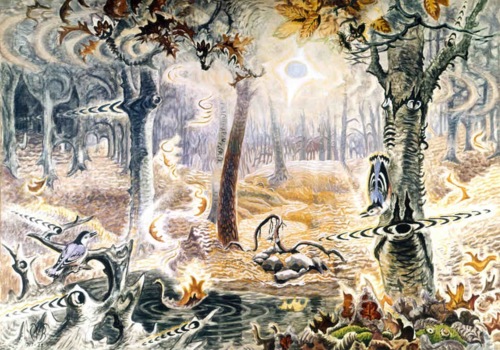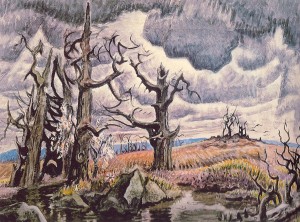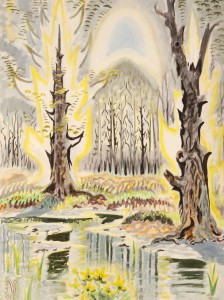
I am fascinated by the works of American painter Charles Burchfield (1893-1967), and was inspired by his visual world to compose a wind quintet and an orchestral tone poem (The Sphinx and the Milky Way). The premiere of my wind quintet Watercolors, the winner of NEC’s 2010-2011 Honors Ensemble Composition Competition, will be performed on Thursday, May 12th at 8:00pm in Jordan Hall at New England Conservatory (290 Huntington Avenue, Boston, MA, 02115) by Andra Winds, who were selected this year as an NEC Honors Ensemble. I’m very honored to have my work performed by this talented group in beautiful Jordan Hall.

Watercolors references four watercolor paintings completed during Burchfield’s late period (the mid-1940s-60s). Although the paintings were not created as a set, I selected them for their complementary contrasts and connections.
Burchfield’s dynamic style and almost psychedelic imagery are arrestingly unique. His haunting paintings speak of a spiritual world of transcendence, redemption, decay and renewal, and he depicted the wonders of nature (the patterns on a sphinx moth’s wing; moonlight filtering through the petals of a sunflower) in an artistic voice that is as distinctive as it is beautiful.

Each movement of Watercolors reflects my impression of an individual painting. The paintings depict natural environments in different seasons or moods, from the barren rainstorm landscape seen in An April Mood to the luminous forest of Glory of Spring. At times, musical references to the visuals are direct (the bird or insect-like motifs in Autumnal Fantasy, for example), but more often than not, my music is an interpretation of the paintings’ overall atmospheres.
It is interesting to note that Burchfield himself was a passionate music fan (which helps to explain why his paintings are so suggestive of music). His copious journals reveal that he favored Beethoven, Wagner, and Sibelius, and created artworks inspired by his listening. Burchfield was sensitive to sound, especially the sounds of nature, and some of his paintings contain abstract patterns that directly represent sounds (see Autumnal Fantasy, The Insect Chorus [1917] or Song of the Telegraph Poles [1917-1952]). These images pulsate with energy, and imply a world of sensory experience.